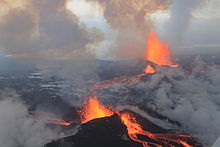Holuhraun
Coordinates: 64 ° 51 ′ 9 ″ N , 16 ° 49 ′ 53 ″ W.
Holuhraun is a lava field in the Icelandic highlands north of Vatnajökull that was created by fissure eruptions .
Surname
After a research expedition in 1880, the lava field was initially called Kvíslarhraun . This refers to the numerous headwaters (Icelandic kvísl = branch; branched brook) of the Jökulsá á Fjöllum , which flow from the Dyngjujökull glacier here and in the vicinity .
Four years later it was given its current name by the geologist and geographer Þorvaldur Thoroddsen .
Affiliation
Until recently, the lava field was part of the Askja volcanic system . Recent studies show, however, that the composition of the lava suggests that it belongs to the Bárðarbunga system.
Most recent outbreak series 2014–15
On the night of August 28-29, 2014, a fissure eruption began in Holuhraun, at the northern end of a magma intrusion that had been moving north from Bárðarbunga since August 16 . In the further course, a main crater with a lava lake formed, which now fed the lava flows. By the end of the eruption in February 2015, around 1.4 km³ of new lava had been produced on an area of 85 km², Gíslason et al. estimate the amount of lava to be 1.6 ± 0.3 km³. In Iceland itself, the unusual amount of gases emitted (especially sulfur compounds) caused a number of problems.
Various names have been suggested for the lava field that was newly created in 2014–2015. A committee of the rural community Skútustaðir , in whose area the lava field is located, voted on four proposals at the end of 2015: Flæðahraun , Nornahraun , Urðarbruni and the previous name, Holuhraun . It was decided to keep the name Holuhraun .
See also
Web links
Individual evidence
- ↑ a b Holuhraun ( English ) Nordic Adventure Travel. Retrieved August 29, 2014.
- ↑ ME Hartley, T. Thordarson: The 1874–1876 volcano-tectonic episode at Askja. (PDF, English)
- ↑ Fissure eruption in Holuhraun lava field ( English ) Ríkisútvarpið. Retrieved August 29, 2014.
- ↑ Iceland Magazine (accessed November 18, 2014)
- ↑ See e.g. B. University of Iceland. Institute of Earth Sciences. http://earthice.hi.is/bardarbunga_holuhraun (English)
- ↑ Icelandic Meteorologic Institute (IMO), The eruption has come to an end , accessed March 25, 2017
- ↑ a b cf. E.g .: SR Gíslason et al .: Environmental pressure from the 2014–15 eruption of Bárðarbunga volcano, Iceland. Geophysical Research Letters, 2015.Retrieved January 20, 2016
- ^ Paul Fontaine: Holuhraun to be named Holuhraun ( English ) In: The Reykjavík Grapevine . December 16, 2015. Accessed May 24, 2016.



